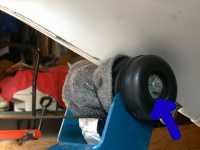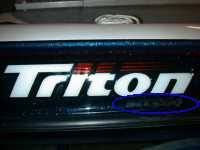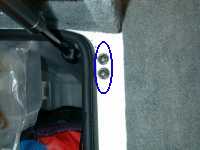
Rip's Tips - Fixing Stuff  |
Other tip pages: general comments | rigging | settling in | fixing stuff | gadgets | discussion
This particular tip page highlights a few things my Triton or Mercury
dealers serviced in the first few years to insure customer satisfaction...
|

above - the bow stop with washer added above - a new Stotlz bow stop |
Tip/Troubleshoot: Washers For Bow
Stop - Take a moment to check your
Triton trailer's bow stop roller to be sure
washers and not just a bolt retain the end
caps.
As I pulled onto my trailer, an end cap popped off the rubber bow stop at the trailer winch, scratching a little fiberglass just above the bow eye. I discovered there were no retaining washers in the rubber end caps. I snapped the end cap back on over the bolt. Back home, I added washers to the end caps (see washer behind bolt in picture upper left) and tied some carpet over the rubber stop as my own temporary solution. If you learn of a better solution, please email me.
Update... I contacted MFI, my tandem trailer manufacturer (www.metfabinc.com). They're currently using washers in the end caps. My end cap continued to remain secure after adding washers. I tried this simple fix for a while. MFI was very cooperative. Some readers suggested an aftermarket solution, the Stoltz Ultimate Bow Stop, available from marine suppliers like Bass Pro Shops. They say it's material is better for white colored bows too. Yep, I had my dealer put a 4" Stoltz on my trailer after giving the OEM black roller a chance for a couple more months. I grew tired of cleaning the black marks from the roller off the white hull. The Stoltz is a definite improvement (bottom picture at left). Keep it clean to reduce grime marks. |

above - Earl Bentz decal gone, goo left above - TR21 decal gone |
Tip/Troubleshoot: Decals - I discovered
that my "Earl Bentz" decal simply peeled
away while running down the lake. It just
left goo where it used to be. See, it's not
just Ray Scott's hat that gets blown off
like in the old Triton ads.
Then I discovered that one of my TR-21 decals disappeared. Others aren't sealed well either. Awaiting solution via a scheduled appointment with dealer. If you have learned about some solution, please email me.
Update... Thanks for all the suggestions to drive a little slower so as not to peel stuff off my boat. A solution was quickly identified. Your dealer should be able to replace any decal that had adhesive problems. Simply call and report your problem, so they can request replacements from the factory. |
| Tip/Troubleshoot: Lid Support Screws
- A reader on the BFHP boat/motor
message page offered an alert and
solution about screws for support rods
on certain compartment lids dripping a
little in a heavy rain.
The readers tip... simply loosen screws, apply a touch of sealant, and retighten these if you experience some dripping water into your tackle and rod compartments. If you have a better solution, please email me.
Update... When I finally got soaked one day, only my center compartment seemed to have a small drip (see picture right top). I did sealant on all my compartments cuz this solution was so easy. And here's my extra tips for you or your dealer...
While on the compartment topic, Triton uses a quality T-H Marine pedestal drain assembly on the front pedestal. The drain tube is routed through the huge front compartment (see picture right bottom) into the bow under the front accessory panel. There, the tube should be positioned so it travels back under the front compartment and drains down the center of the boat. If it gets pulled out of place while wiring accessories up front, you may notice rain water flowing into the front of either rod compartment located left and right of the front compartment. Simply reroute it back down the middle. Oh yeah, notice how BIG that compartment is. |

above - lid support screws on my center compartment above - forward area under deck in front compartment |
Return to Rip's Triton Tips main page.
Also consider exploring BBC Home Page for Bryan Bass Club information and links to other bass fishing/boating sites.
Ray's Triton Page | Buying Adventure | Area Dealers | Rip's Triton Tips | Other Links | BBC | Ripstips Home
For corrections on this page series, please contact Ray Rippstein at r-rippstein@tamu.edu
Thanks for visiting.
This intro page last updated July 3, 2006